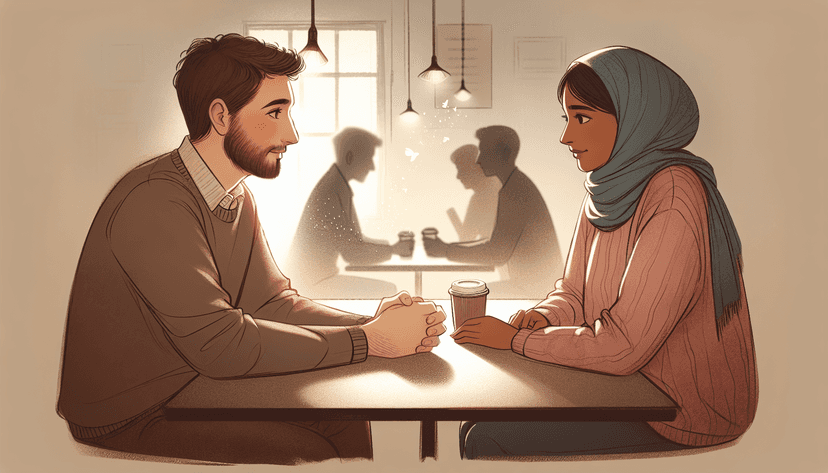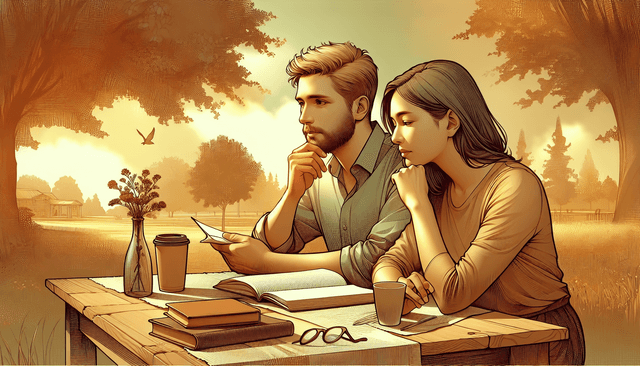Table of Contents
We’ve all been there—watching two friends flirt awkwardly while everyone around them shouts, “Just kiss already!” It’s a classic scenario, and it’s no wonder that the friends-to-lovers trope captures our hearts. There’s something undeniably charming about the slow burn of friendship blossoming into something deeper.
But don’t worry! If you’re stuck and need a bit of inspiration, you’re in the right place. By sticking around, you’ll discover a treasure trove of prompts and ideas that will ignite your creativity and help you write that captivating love story you’ve been dreaming of.
So, whether you’re a seasoned writer or just dabbling in storytelling, get ready to explore the nuances of friends becoming lovers, the various scenarios that make it special, and the techniques to bring your characters’ journey to life.
Key Takeaways
- Friends to lovers stories explore the transition from friendship to romantic love, which is relatable and engaging.
- Use prompts like jealousy over new relationships or shared vulnerabilities to spark creativity.
- Different scenarios, like childhood friends or workplace buddies, can add variety to your narrative.
- Character development is key; allow characters to evolve as they confront their feelings.
- Utilize internal monologues, relatable dialogue, and moments of conflict to enhance emotional depth.
- Common themes include unexpressed feelings, timing, and personal growth between characters.

Friends to Lovers Prompts to Spark Your Imagination
If you’ve ever binged a rom-com or read a sweet love story, you’ve likely come across the friends to lovers trope. This classic theme can be heartwarming and relatable, exploring the transition from friendship to romantic love. To kickstart your writing journey, here are some prompts that can ignite your creativity.
Imagine two best friends, recently out of a long-term relationship, finding solace in each other’s company. Their shared understanding of heartbreak leads to unexpected feelings. Or consider a scenario where one friend starts dating someone new, prompting jealousy and self-reflection in the other. Such moments create tension that can lead to a deep exploration of feelings.
Whether it’s through shared dreams, late-night talks, or navigating life’s ups and downs together, the possibilities are endless. Think about how small gestures can turn a platonic friendship into something deeper. For example, they might start noticing each other’s quirks in a new light after a few awkward hugs or accidental touches during game night.
Understanding Friends to Lovers Trope
The friends to lovers trope revolves around characters who start as friends but ultimately realize their feelings go beyond platonic affection. This storyline often captures the complexity of emotions, as characters grapple with fear of losing the friendship versus the potential for a deeper connection.
What makes this trope so compelling is its relatability. Many readers can connect to the idea of having strong feelings for a friend, leading to an internal struggle. Crafting this tension authentically can elevate your narrative, allowing readers to empathize with the characters’ journey.
The transition can either be gradual or abrupt. Sometimes, a pivotal moment—a life crisis, a kiss during a heated game, or a moment of vulnerability—can act as the catalyst. Other times, the realization can come slowly, built through shared experiences or subtle shifts in behavior.
Different Types of Friends to Lovers Scenarios
Friends to lovers isn’t one-size-fits-all; there are several variations of this scenario that can add depth to your story. Here are a few types you might consider exploring.
- Childhood Friends: This scenario taps into nostalgia. Two characters grow up together, and as they transition into adulthood, they start seeing each other through a romantic lens.
- Roommates: Sharing living space can create intimacy. You can explore how daily life fosters closeness, leading to the gradual shift from friends to romantic partners.
- Best Friend’s Sibling: A classic dynamic where one friend has feelings for their best friend’s sibling. This scenario brings in elements of tension and potential conflict, especially if the best friend is unaware.
- Workplace Friends: Picture two colleagues who bond over shared projects. Their teamwork and late nights can bring them closer, blurring the line between friendship and romance.
Benefits of Writing Friends to Lovers Stories
Writing friends to lovers stories can be both rewarding and engaging. Firstly, you get to explore multifaceted relationships that evolve over time. This gives you the opportunity to develop rich characters who can grow alongside each other.
A major benefit is the built-in emotional stakes. Readers are invested in friendships, so when romantic feelings emerge, the tension becomes palpable. This can create a deeper narrative as you navigate their fears, insecurities, and the potential fallout of changing their relationship.
Moreover, writing this trope allows for humor and lighthearted moments, providing a perfect balance to the emotional depth. Puns, inside jokes, and playful banter can fill your dialogue, making the story relatable to anyone who has ever been in a close friendship.
Finally, friends to lovers tales often resonate with readers because they reflect real-life experiences. These stories tap into the universal theme of love blossoming out of companionship, which is endearing and wildly popular in literature and film.

Common Themes in Friends to Lovers Prompts
When it comes to friends to lovers stories, certain themes often emerge that resonate with readers. One prominent theme is the idea of unexpressed feelings. Many friends harbor emotions for each other but keep them hidden due to fear or insecurity.
This creates a tension that can be both intriguing and relatable. Consider a situation where one character grapples with their feelings while the other remains oblivious, building suspense throughout the narrative.
Another common theme is the concept of timing. Sometimes, characters may find themselves in different places in their lives, leading to that pivotal question: Is now the right time to pursue romance? Exploring how timing affects relationships can add depth to your story.
Additionally, the theme of personal growth often plays a significant role. Friends who start as one version of themselves may evolve through their experiences, pushing boundaries and discovering new aspects of their personalities as they navigate their complicated feelings.
Lastly, the theme of friendship itself serves as a foundation for the romance. Highlighting how their bond as friends enhances their relationship adds a layer of authenticity and warmth that readers appreciate.
Writing Techniques for Friends to Lovers Narratives
Writing friends to lovers stories can be both exciting and challenging. One effective technique is to utilize internal monologue. Allow readers to step inside the characters’ minds to experience their fears, doubts, and desires regarding their evolving relationship.
Another technique involves careful pacing. Building tension and delaying the inevitable confession can keep readers on the edge of their seats. Use moments of near-confession, where they almost share their feelings, to create suspense.
Using relatable dialogue is also crucial. The banter between friends often feels natural and lighthearted but can also convey deeper emotions when the moment is right. Infuse the dialogue with witty exchanges that reflect their camaraderie but also hint at burgeoning feelings.
Don’t shy away from moments of conflict. A disagreement can lead to profound realizations about their feelings. These conflicts can serve as turning points in the story, pushing characters to confront their emotions or clarify their intentions.
Lastly, consider employing symbolism to deepen the narrative. An object, location, or shared memory can remind characters of their bond and denote their transition from friends to lovers, adding an emotional layer to the storyline.
Character Development in Friends to Lovers Stories
Character development is crucial in friends to lovers narratives; it transforms the bond from platonic to romantic smoothly. Start by establishing well-rounded characters. Give them unique personalities, backgrounds, and interests that make them relatable and authentic.
Throughout the story, allow growth to happen naturally. Characters should evolve as they navigate their feelings for one another. For instance, a shy character might become bolder as they explore their romantic feelings, while a carefree character learns to be more vulnerable.
Focus on their shared experiences; these moments can highlight how their friendship lays the groundwork for romance. Show how past experiences shaped their relationship and how they use these memories to confront their feelings.
Consider the supporting cast as well. Friends and family can impact how characters view their relationship and their willingness to take the leap from friends to lovers. Use these interactions to further develop the main characters.
Finally, remember that flaws make characters more relatable. Characters with insecurities or fears about love can create tension and provide opportunities for growth, leading to a deeper connection by the end of your story.

Examples of Friends to Lovers Prompts
Examples can be a powerful tool for sparking creativity, especially when it comes to the friends to lovers trope.
Consider a situation where two friends find themselves snowed in together during a winter storm. As they pass the time, their hidden feelings start coming to the surface.
Another prompt could involve friends who make a pact to help each other find love. But as they embark on this journey, they begin to realize that the love they are searching for has been right in front of them all along.
What about a scenario where one character returns to their hometown for a wedding and reconnects with their childhood best friend? The nostalgia and unresolved feelings could create a perfect storm for romance to blossom.
Lastly, how about two friends who are forced to become “fake” couple for a family event? The pretend aspect can layer in humor, but as they navigate the facade, real feelings emerge.
How to Use Friends to Lovers Prompts for Writing
Using prompts effectively can ignite inspiration and help you build compelling narratives.
Start by selecting a prompt that resonates with you. Think about what excites you about the scenario and how you envision the characters’ dynamics.
Next, sketch out your characters. Think about their backgrounds, personalities, and the history they share. This will help create depth and make the evolution from friends to lovers believable.
Make a basic outline of your story. Identify key moments where tension can build, like awkward encounters, emotional confessions, or moments of doubt. This helps maintain momentum throughout your narrative.
Don’t forget to infuse your unique voice into the story. Whether it’s humor, drama, or heartfelt moments, your personal touch will make the narrative engaging.
Finally, be open to where the story may lead. Sometimes the characters have their own ideas about how their relationship should unfold. Letting them take charge can bring unexpected turns that keep readers invested.
Inspiration for Friends to Lovers Storylines
Finding inspiration can be as easy as looking at your own relationships or those around you.
Writers often pull from personal experiences and observations, so try reflecting on friendships that have evolved in your life.
Pop culture can also be a goldmine. Movies, TV shows, and books provide countless examples of the friends to lovers trope that can spark ideas.
Consider exploring different settings and contexts. How might this trope play out in a fantasy world, a dystopian future, or amidst a summer getaway?
Journaling about random scenarios or “what if” questions can lead to fresh story ideas. What if two friends went on a road trip together? What if one suddenly got a job offer in another country?
Lastly, try brainstorming with other writers. Sharing ideas can boost creativity and lead to breakthroughs you might not have thought of on your own.
Conclusion: Embracing the Friends to Lovers Journey
The friends to lovers trope is a journey that resonates with many, drawing on the emotional intricacies of friendship and love.
As a writer, embracing this trope allows you to explore rich character dynamics and relationships.
Each story is an opportunity to navigate the tension between platonic and romantic feelings while highlighting personal growth.
So, take a moment to savor the ride, whether it’s through writing prompts, character development, or engaging storylines.
Remember, love can emerge in the most unexpected places, often starting from the strongest of foundations—friendship.
FAQs
The Friends to Lovers trope appeals due to its blend of comfort and tension, showcasing deep emotional connections and the thrill of discovering romantic feelings within an established friendship.
Focus on their shared experiences, contrasting personalities, and individual growth. Allow for moments of vulnerability and conflict to highlight the shift from friendship to romance, enhancing character depth.
Common themes include friendship challenges, jealousy, moments of realization, and the exploration of unspoken feelings. These themes enhance the emotional stakes and complexity of the relationships.
Start by choosing a prompt that resonates. Then, explore character backgrounds, set up relatable conflicts, and build tension gradually, ensuring a satisfying evolution from friendship to romantic love.



